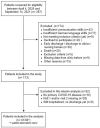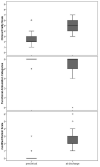Critical COVID-19 disease: Clinical course and rehabilitation of neurological deficits
- PMID: 36388208
- PMCID: PMC9649895
- DOI: 10.3389/fneur.2022.1012685
Critical COVID-19 disease: Clinical course and rehabilitation of neurological deficits
Abstract
Background: The COVID-19 disease frequently causes neurological symptoms. Critically ill patients often require neurorehabilitation for manifestations like intensive care unit (ICU) acquired weakness or encephalopathy. The outcome of these patients, however, is largely unknown. Here we report the clinical course of critical affected COVID-19 patients from hospital admission to discharge from inpatient neurorehabilitation.
Methods: Prospective cohort study. COVID-19 patients admitted to neurorehabilitation were included based on a laboratory-confirmed SARS-CoV-2 infection. Assessments [modified Rankin Scale (mRS), Barthel-Index, Fatigue-Severity-Scale-7 and health-related quality of life (EQ-5D-5L)] were conducted at admission and before discharge from inpatient care. Data were compared to the preclinical health status.
Results: Sixty-one patients (62 ± 13 years, 16 female) were included in the analysis. Most patients had been treated on ICU (n = 58; 57 ± 23 days) and had received invasive ventilation (n = 57; 46 ± 21 days). After discharge from ICU, patients spent on average 57 ± 26 days in neurorehabilitation. The most frequent neurological diagnoses were ICU-acquired weakness (n = 56) and encephalopathy (n = 23). During rehabilitation overall disability improved [mRS median (IQR) 4.0 (1.0) at inclusion and 2.0 (1.0) at discharge]. However, the preclinical health state [mRS 0.0 (0.0)] was not regained (p < 0.001). This was also reflected by the Barthel-Index [preclinical 100.0 (0.0), at inclusion 42.5 (35.0), at discharge 65.0 (7.5); p < 0.001]. Patients had only minor fatigue during inpatient care. Quality of life generally improved but was still low at discharge from hospital.
Conclusion: Patients with neurological sequelae after critical COVID-19 disease showed substantial deficits at discharge from inpatient care up to 4 months after the initial infection. They were restricted in activities of daily living and had reduced health-related quality of life. All patients needed continued medical support and physical treatment.
Keywords: COVID-19; SARS-CoV-2; critical care outcomes; neurological manifestations; neurological rehabilitation.
Copyright © 2022 Wimmer, Egger, Bergmann, Huge, Müller and Jahn.
Conflict of interest statement
The authors declare that the research was conducted in the absence of any commercial or financial relationships that could be construed as a potential conflict of interest.
Figures




References
-
- Rogers JP, Watson CJ, Badenoch J, Cross B, Butler M, Song J, et al. . Neurology and neuropsychiatry of COVID-19: a systematic review and meta-analysis of the early literature reveals frequent CNS manifestations and key emerging narratives. J Neurol Neurosurg Psychiatry. (2021) 92:932–41. 10.1136/jnnp-2021-326405 - DOI - PubMed
LinkOut - more resources
Full Text Sources
Miscellaneous

